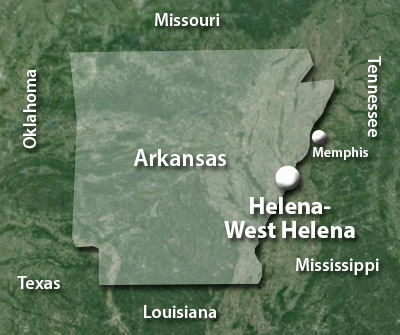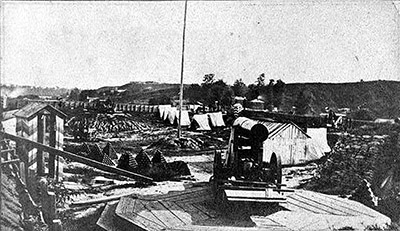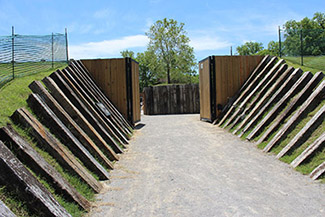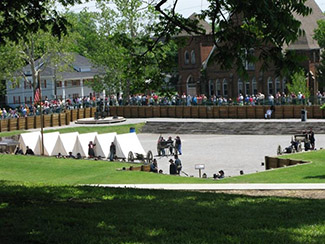 |
Fort Curtis
Helena-West Helena, Arkansas, United States
|
|
 |
Constructed: 1862
(Reconstructed 2011)
Used by: United States
Conflict in which it participated:
US Civil War
|
Helena was founded in 1833 as a port city on the Mississippi River, taking advantage of a slight elevation that made the area safer from flooding.
Arkansas was admitted to the Union as a state in 1833. When southern states began seceding from that Union at the beginning of 1861, Arkansans initially wished to remain with the United States. When President Abraham Lincoln (1809-1865) demanded troops from Arkansas to help quell the rebellion at Fort Sumter at Charleston, South Carolina, however, Arkansas became the ninth state to secede on May 6, 1861. |
 |
 |
|
Arkansas' eastern border is the Mississippi River, which was incredibly important to everybody involved in the US Civil War (1861-1865), as the lifeline to the Confederacy's western states. Brigadier General Samuel Ryan Curtis (1806-1866), after whom the starfort of our current interest would be named, led a Union army of 10,250 and 50 artillery pieces into northern Arkansas in early 1862.
|
 The interior of Fort Curtis during the Civil War. This is the only photo of the fort in war days known to exist. |
 |
After defeating a Confederate force of 16,000 under Major General Earl Van Dorn (1820-1863) at the Battle of Pea Ridge on March 6-8, 1862, Curtis and his small army cut a merry swath through Arkansas, ending up at Helena in July.
The following month, Curtis directed that a fortification be constructed at Helena, for the defense this strategic location that the Confederacy would eventually want back. Many escaped slaves, known as Contrabands, followed Curtis' army as it moved through Arkansas, and they became the workforce that built his fort. |
|
|
These ex-slaves may or may not have been okay with this arrangement, but one General Eugene Carr (1830-1910) was most definitely not. Contrabands were being seized from other work details to lend a hand with fort construction, which Carr found distasteful. "...there is no security for those [who] in good faith have engaged in labor in our service," complained Carr, who seemed more displeased by the manner in which these men were collected to do the work, than by the fact that they were being made to work in the first place. Whatever, many of the men who had built Fort Curtis would, in April of 1863, volunteer to enter service with the US Army, units to which would later be referred as US Colored Troops (USCT).
Fort Curtis was an earth-and-timber, four-bastioned starfort, which mounted three 24-pounder guns. The fort was manned by two companies of the 33rd Missouri Volunteer Infantry during the war. Five other fortifications in and around Helena were Fort Pinney, which was a smaller outpost along the river, and four two-gun batteries.
|
By July of 1863, the Confederate stronghold of Vicksburg, Mississippi had almost been captured by Union forces. The South was desperate to lessen the pressure on its beleaguered forces there, and chose to attack the Union fortifications at Helena on July 4th as both a means of lessening that pressure (as Union supplies and men were steaming south down the Mississippi River to Vicksburg from Helena and beyond) and enjoying a fun Independence Day activity.
Arrayed in and around Helena were 4,000 Union troops, backed up on the river by the USS Tyler, a "timber-clad" steamboat, armed with one 32-pounder gun and six 8-inch guns.
|
 |
 The USS Tyler, launched in 1857. The USS Tyler, launched in 1857. |
|
Timber-clad?! A steamboat "protected" with wooden "armor." Which sounds to me like "a boat." Well no, if its sides were made of thicker wood than usual, and its paddlewheel were somewhat protected, then...sure. Timber-clad. Sorry, this is just the first time I'm being confronted with this seeming contradiction. I'll get over it. Moving on.
|
| Ole man Curtis on his trusty steed: Placed on the riverfront at Keokuk, Iowa in 1898. |
 |
Though the Confederates attacked with nearly twice as many troops as the Union had defending, it's always easier to defend than to attack (especially when there's a starfort, manned by determined men, involved). An inability to coordinate his army ultimately led Lieutenant Colonel Theophilus H. Holmes (1804-1880), commander of the Confederate forces, to defeat. The boys in grey managed to capture one of Helena's gun batteries, but were unable to hang onto it, faced with concentrated fire from exquisitely fortified defenders and the guns of the USS Tyler.
Helena remained a Union stronghold on the Mississippi, serving as a base for the successful capture of Little Rock, Arkansas later in 1863.
a few months after the Civil War ended in April of 1865, the US Army removed Fort Curtis' guns and shipped them out of Arkansas. The army left Helena in 1867, and Arkansas was readmitted into the United States in June of 1868. Fort Curtis was leveled, and a Baptist church was built there.
In 1992, the construction of a New Fort Curtis was first suggested by the Delta Cultural Center, a museum in Helena dedicated to the preservation of the culture of the Arkansas Delta region. |
|
|
In March of 2005, Helena merged with West Helena, creating the charmingly oblivious town name of Helena-West Helena, Arkansas. "New Fort Curtis" was built in 2011, three blocks south of its original location, and at about 75% of its original size. It was dedicated on May 11, 2012, and is today open to the public.
|
 New Fort Curtis' Sally Port, or main gate. New Fort Curtis' Sally Port, or main gate. |
 |
 The interior of New Fort Curtis. The interior of New Fort Curtis. |
|
Many thanks to tireless starfort enthusiast Ben, who found Fort Curtis for us!
|
|
|
|
|
|
 |




